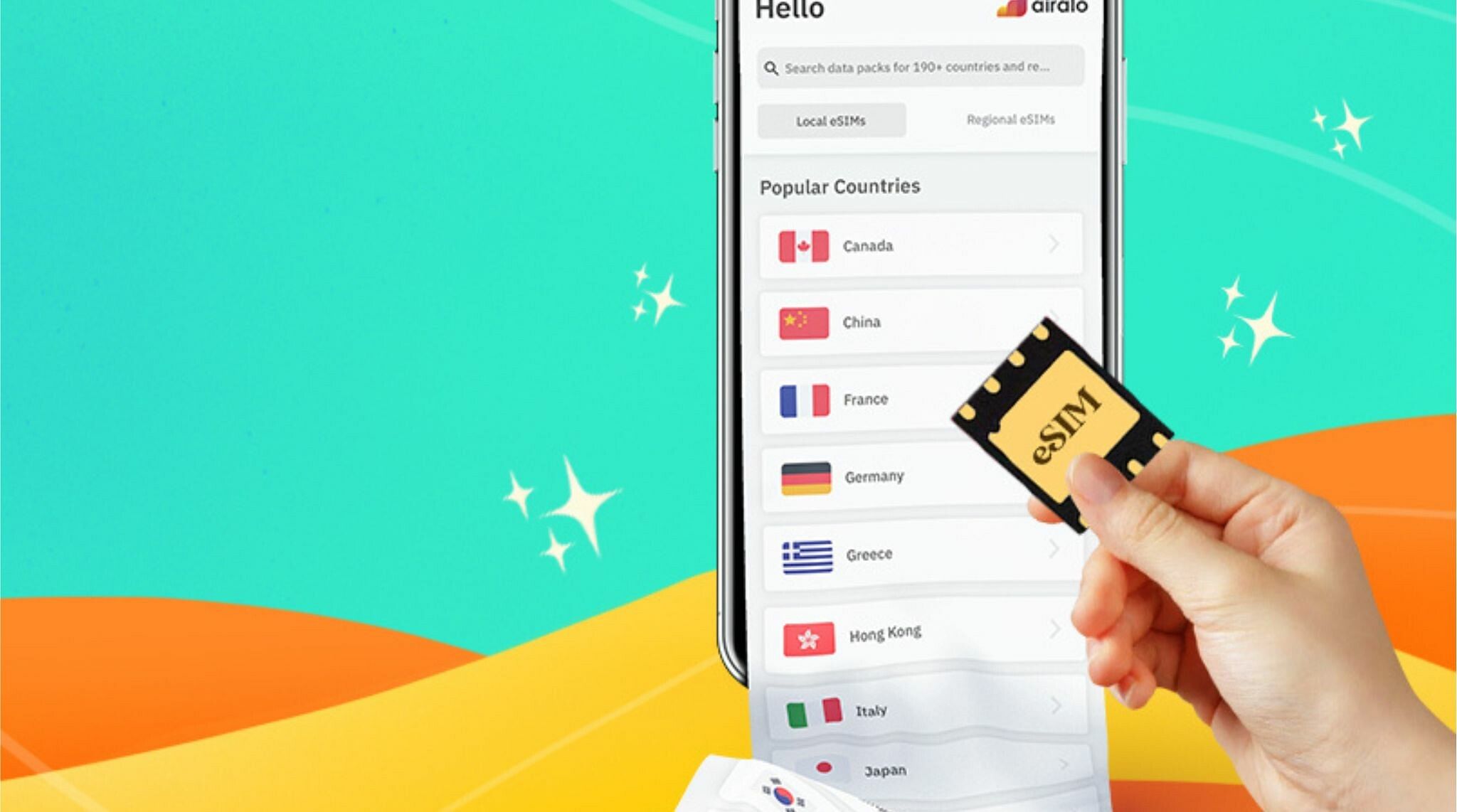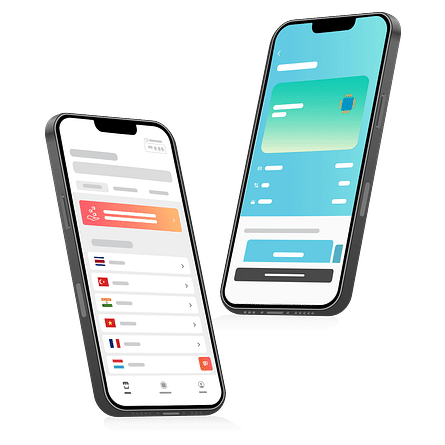
As we move into 2025, eSIM technology is no longer just a convenience; it's becoming the standard for global connectivity. With its ability to offer seamless, flexible, and secure personal and professional communication solutions, eSIM is poised to revolutionize how we connect. In this blog, we'll explore the future of eSIM technology, from its growing adoption to groundbreaking innovations that will shape the digital landscape in 2025 and beyond.
You will find in this blog:
- Understanding eSIM Technology
- eSIM Adoption: Becoming the Global Standard
- Innovations Shaping eSIM Technology in 2025
- The Impact of eSIM on Key Sectors
- eSIM and Mobile Industry Transformation
- Challenges Facing eSIM Technology
- Opportunities for eSIM Technology
- Top FAQs about the Future of eSIMs
- Stay Connected Wherever You Go with an eSIM from Airalo
Understanding eSIM Technology
eSIM, short for embedded SIM, is a virtual SIM card built directly into a device's hardware, eliminating the need for a physical SIM card. It allows users to store multiple network profiles and switch between them seamlessly, all from the device itself. Unlike traditional SIM cards, eSIM technology lets users remotely activate a cellular plan without visiting a store or waiting to deliver a SIM card. This revolutionary technology represents a significant step forward in connecting to mobile networks, offering greater flexibility and convenience for users.
Traditional SIM Cards vs eSIMs
Traditional SIM cards have been around for decades, physically inserted into our phones to provide unique identification on the network. These cards are removable, which has advantages, such as quickly transferring the card to another device. However, physical SIM cards also have limitations, like the hassle of replacing them when switching carriers or moving between countries. eSIMs, on the other hand, bring us into the digital era with their embedded setup, requiring no physical handling. They can be reprogrammed over the air within moments. Users can switch carriers, try different plans, or connect to new networks without fuss. In essence, eSIM technology is designed to offer the same functionalities as traditional SIMs but with added freedom and simplicity that align with the advancing digital lifestyle.
What's iSIM?
While the tech world buzzes with talk of eSIM, another intriguing development is emerging: iSIM, or integrated SIM. This innovative approach integrates the SIM function directly onto a device’s processor, enabling even more space-saving and design flexibility. The primary difference between eSIM and iSIM is about integration. Where eSIM still requires a dedicated slot on the device’s hardware, iSIM blends into the processor, potentially reducing the costs and space associated with manufacturing these components. Thanks to its system-wide integration, iSIM also promises further improvements in terms of security and performance. The advent of iSIM could complement or even challenge eSIM as the new frontier in mobile connectivity. Both technologies aim to simplify connectivity even further and make our devices smarter and more efficient.
Where Does eSIM Technology Stand Today?
Since 2023, eSIM technology has been gaining traction yet faces gradual adoption. It's been embraced by several leading smartphone manufacturers, with Apple and Samsung paving the way. Their recent phone models have eSIM capabilities, reflecting the industry’s move toward this new standard. However, the full potential of eSIMs has yet to be realized. A significant barrier to widespread adoption is that not all mobile carriers globally fully support this technology. Efforts are underway to make eSIMs the new norm, with more carriers jumping on board due to the increasing demand from tech-savvy consumers who desire easier and more flexible mobile connectivity options.
Related: How eSIM Technology Revolutionizes Business Travel in the Middle East

eSIM Adoption: Becoming the Global Standard
Mainstream Integration Across Devices
The future of eSIM is not limited to smartphones. By 2025, expect widespread adoption across devices like laptops, tablets, smartwatches, and even IoT gadgets. This expansion will streamline connectivity, enabling users to manage all their devices seamlessly under a single network.
Driving Forces Behind Adoption
- Sustainability: As the world prioritizes eco-friendly solutions, eSIM eliminates the need for physical SIM cards, reducing plastic waste.
- Telecom Industry Shift: Mobile carriers are increasingly supporting eSIM due to its ability to reduce logistical costs and simplify customer onboarding.
- Regulatory Support: Governments worldwide recognize the benefits of eSIM and implement policies to encourage its use.
Innovations Shaping eSIM Technology in 2025
-
Enhanced Security Features
As cybersecurity threats evolve, eSIM technology will incorporate advanced encryption and authentication protocols to ensure safer digital communication. Features like biometric verification and AI-powered fraud detection will likely become standard.
-
Enhanced Connectivity and Coverage
With an embedded setup, eSIMs lay the groundwork for genuinely global devices capable of connecting to multiple networks worldwide without physical changes. This could particularly benefit travelers who often switch SIM cards for local networks. By 2025, more mobile carriers are expected to provide streamlined eSIM services, offering better global coverage. Also, 5G technology integration alongside eSIM will likely lead to a future where connection interruptions become rare. This reliable global connectivity will step up mobile usage possibilities, opening the door for an always-on and ubiquitous internet experience wherever you are.
-
Improved User Experience and Customization
User experience is set to take center stage in the future of eSIM. By 2025, activating and managing your mobile plan is anticipated to become even more intuitive and hassle-free. Imagine signing up for a new cellular plan with just a few taps on your smartphone, no waiting, and no physical card necessary. Customization will also offer a significant leap forward. Users could adjust their mobile services in real-time, personalizing their plans according to their changing needs—whether increasing data on a road trip or seamlessly switching carriers when traveling internationally. With such advancements, the eSIM will cater to a future that values user control and personalized technology interaction.
-
AI-Powered Network Optimization
Artificial intelligence will enable eSIMs to automatically switch to the best available network, optimizing for speed, cost, and reliability. This will be especially useful for travelers and professionals in remote areas.
-
eSIM for IoT Expansion
The rise of the Internet of Things (IoT) is tied closely to the potential growth of eSIM technology. As IoT devices, from smartwatches to home security systems, become more widespread, their ability to connect independently, without tethering to a smartphone, will become vital. Here, eSIMs come into play, enabling these devices to connect autonomously and securely to cellular networks. By 2025, eSIM technology will be a staple in automotive, health tech, and other utilitarian devices. For example, cars equipped with eSIMs could offer direct connectivity for navigation, roadside assistance, or real-time diagnostics. In healthcare, wearables use eSIMs to continuously monitor without relying on a phone. The seamless integration of eSIMs with IoT will represent a quantum leap in how devices operate and interact in a connected ecosystem, simplifying connectivity and expanding capabilities across various sectors.
Related: Mindful Connection: How eSIMs Simplify Tech Use, So You Can Focus on the Moment

The Impact of eSIM on Key Sectors
-
Business and Remote Work
For business travelers and remote workers, eSIM will offer unparalleled convenience. Instant activation, global coverage, and cost-effective data plans will make it easier than ever to stay connected across borders without the hassle of traditional SIM cards.
-
Consumer Convenience
Consumers will enjoy simplified processes for switching networks, upgrading plans, and managing multiple devices—all without needing to visit a store or swap physical cards.
-
Telecommunication Providers
For telecom operators, eSIM will open doors to new revenue streams through innovative subscription models, enhanced user experiences, and reduced operational costs.
eSIM and Mobile Industry Transformation
The mobile industry is no stranger to change, and the eSIM technology is one of the most exciting transformations on the horizon. As we look towards 2025 and beyond, the adoption of eSIMs promises to reshape the landscape in profound ways, affecting mobile carriers, consumer behavior, and device manufacturers alike.
Impact on Mobile Carriers
The introduction of eSIM technology presents a mixed bag for mobile carriers. On one hand, it offers opportunities to improve customer experience. Conversely, it forces carriers to adapt to a new competitive environment.
- Flexibility for Consumers: With eSIMs, consumers can easily switch carriers. This can increase churn rates as customers can easily compare and swap between service providers without the hassle of changing physical SIM cards.
- Opportunity for Innovation: Carriers are motivated to innovate, offering better deals and personalized services to retain customers. This can lead to improved service offerings and the development of new data plans tailored to specific needs.
- Global Reach: eSIMs enable easier international roaming, expanding service reach. Mobile carriers may collaborate with foreign networks to offer seamless connectivity for globetrotters.
Consumer Behavior Shift Globally and in the MENA Region
The shift to eSIM technology will likely significantly influence consumer behavior globally and, particularly in the MENA (Middle East and North Africa) region,
- Simplified Connectivity: The transition to eSIMs means a more convenient mobile experience for consumers. No longer tied down by physical SIM cards, users can enjoy more freedom in choosing and switching between service providers.
- Enhanced Travel Experience: For those who frequently travel, especially in the MENA region, with its diverse mix of international visitors and expats, eSIMs can revolutionize connectivity. They remove the hassle of multiple SIM cards and complex roaming plans.
- Adoption of IoT Devices: As eSIM technology matures, it supports a broader range of devices. Consumers may increasingly adopt smartwatches, tablets, and IoT devices equipped with eSIMs, amplifying their digital ecosystems.
Related: Everything You Need to Know About Bleisure Travel in Arabia

Challenges Facing eSIM Technology
- Global Standardization: One of the biggest hurdles for eSIM technology is achieving seamless compatibility across countries and mobile carriers. While many leading telecom providers are adopting eSIM, regions and smaller carriers have yet to fully integrate this technology. Ensuring global standardization will require collaboration among device manufacturers, mobile operators, and regulatory bodies. Without a unified standard, users may face connectivity issues when traveling internationally or switching carriers.
- Consumer Awareness and Education: Despite its growing presence, many consumers are still unfamiliar with eSIM technology and how it benefits them. Misconceptions about its functionality and concerns about setup processes may deter users from embracing it. Educating consumers about the convenience, flexibility, and cost-effectiveness of eSIM will be crucial for driving widespread adoption. Initiatives such as tutorials, guides, and simplified user interfaces will play a pivotal role in bridging this knowledge gap.
- Data Security and Privacy: With digital connectivity expanding, data security and user privacy are paramount. eSIM technology, while inherently more secure than physical SIM cards, still faces risks from cyberattacks and data breaches. As eSIMs gain traction, hackers seeking to exploit vulnerabilities will target them. The challenge lies in implementing robust encryption protocols, multi-factor authentication, and regular software updates to safeguard user data and maintain trust.
- Carrier Adoption and Support: Not all mobile carriers have fully embraced eSIM technology, often due to the cost and complexity of upgrading their systems. Carrier resistance may also stem from fears of losing control over customer retention, as eSIMs make it easier for users to switch networks. Encouraging carriers to invest in eSIM infrastructure and highlighting the long-term benefits will be critical for overcoming this barrier.
Opportunities for eSIM Technology
- Creating a More Interconnected World: eSIM technology is poised to redefine global connectivity. By eliminating the need for physical SIM cards, eSIMs enable users to switch networks effortlessly, fostering a world where mobility and communication are seamless. This is particularly valuable for business travelers, expatriates, and international students who frequently move across borders.
- Driving Digital Innovation Across Sectors: The versatility of eSIM technology extends far beyond personal devices. Its integration into IoT (Internet of Things) devices, smart cars, industrial machinery, and wearable tech opens up endless possibilities for innovation. From smart cities to autonomous vehicles, eSIM will be at the forefront of technological advancements, enabling real-time data exchange and automation on a global scale.
- Enhancing Mobility and Flexibility: For consumers, eSIM offers unparalleled flexibility. Users can instantly activate new plans, switch carriers, and manage multiple profiles on a single device. This flexibility enhances user experience and empowers individuals to make cost-effective decisions tailored to their needs.
- Boosting Sustainability: The shift from physical SIM cards to eSIM technology represents a significant step toward sustainability. By reducing plastic waste and eliminating the logistics of manufacturing and shipping physical SIM cards, eSIMs contribute to a greener and more environmentally conscious future.
- Empowering Telecommunication Providers: While some carriers may view eSIM as a challenge, it also presents opportunities for innovation. Telecom providers can introduce dynamic pricing models, subscription-based services, and customized plans to attract and retain users. Additionally, eSIM technology reduces the operational costs of producing and distributing physical SIM cards, leading to more efficient business practices.
Related: How eSIM Technology Contributes to Environmental Sustainability

Top FAQs about the Future of eSIMs
-
How will eSIMs impact mobile connectivity?
eSIMs are set to enhance the flexibility and efficiency of mobile connectivity. They make it easier for users to switch providers without the hassle of swapping physical cards. This increased flexibility will likely boost competition among telecom providers, leading to more attractive plans for consumers.
- Will traditional SIM cards become obsolete?
While eSIMs are poised to become more mainstream, traditional SIM cards won't disappear overnight. Instead, both technologies will coexist while catering to different consumer preferences and technological infrastructures. Think of eSIM technology as a natural evolution rather than a sudden takeover.
- Are eSIMs secure?
Security is understandably a top concern for users considering the shift to eSIMs. Fortunately, eSIMs benefit from robust encryption standards, similar to physical SIMs. This ensures that your data and connectivity remain secure, reducing the risk of unauthorized access.
- How will eSIMs influence global travel?
For frequent travelers, eSIMs are a game-changer. They allow users to easily switch to local carriers without purchasing new SIM cards, potentially saving time and reducing roaming charges. Shortly, expect smoother connectivity experiences while globetrotting.
- What advancements can we expect in eSIM technology by 2025?
By 2025, eSIMs will likely feature more streamlined provisioning processes and broader compatibility across devices beyond smartphones, such as laptops, IoT devices, and wearables. Additionally, with 5G becoming more prevalent, eSIMs will play a pivotal role in harnessing its full potential.
Related: 9 Advantages of Traveling With an eSIM

Stay Connected Wherever You Go with an eSIM from Airalo
Stay connected with an eSIM from Airalo no matter where you travel. Airalo gives you access to affordable eSIMs for 200+ countries and regions.
Why Airalo? Here are a few reasons to use an Airalo eSIM when you travel:
- Connect to a mobile network within minutes of arrival.
- Choose from flexible local, regional, and global data plans.
- Eliminate the need to find a local SIM vendor.
- Say goodbye to expensive roaming charges.
- Store multiple eSIM data plans on your device.
- Running out of data? Top up in the Airalo app.
Download the Airalo app (iOS | Android) or visit the Airalo website for a smooth experience. Follow our blog to stay up-to-date about travel, fun destinations, eSIM tech, and more.



